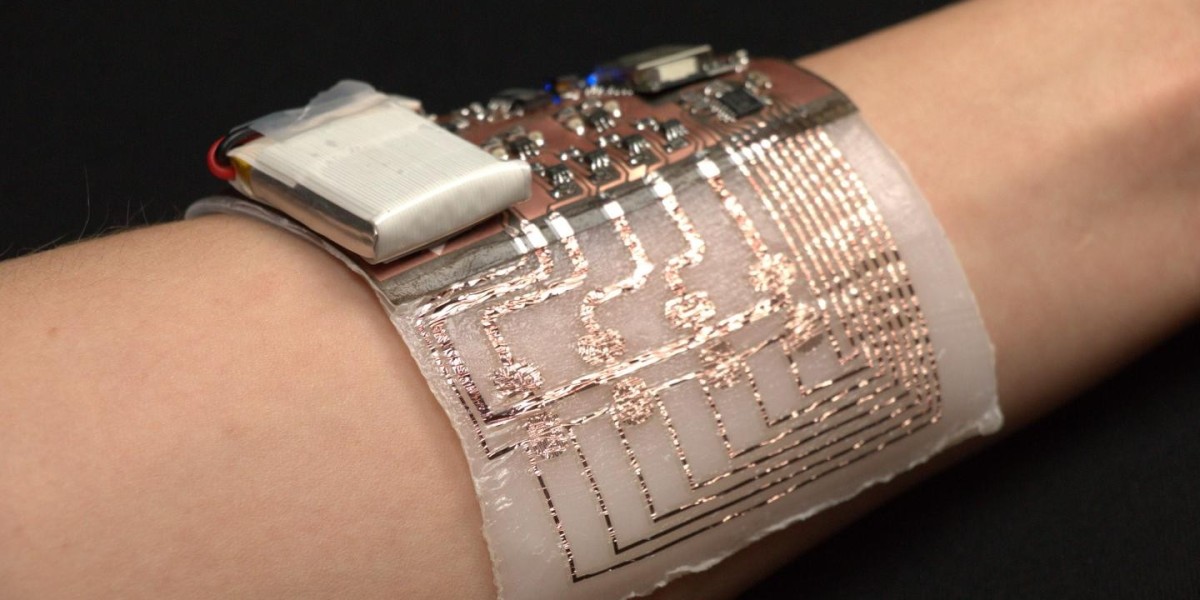With advances in materials science and microfabrication, electronic skin or e-skin has emerged as a new technology that aims to revolutionize healthcare. E-skin refers to flexible and stretchable ultrathin interfaces that mimic human skin and can conformably mount on and wrap around non-planar surfaces. The key advantage of e-skin lies in its ability to sense external environmental stimuli through the integration of multifunctional sensors. Early prototypes of e-skin opened exciting opportunities in areas including prosthetics, robotics, healthcare monitoring and diagnosis.
Working Principle of Electronic Skin Industry
At its core, e-skin relies on sophisticated nanomaterial networks and microsystems that can detect pressure, temperature, chemicals and other biological and physical cues. The most common configuration consists of three main components - a flexible substrate, interconnecting circuits and an array of microsensors. The substrate acts as the structural platform and is usually made from materials like silicone rubber or plastic that mimic skin elasticity. Patterned atop the substrate are extremely thin metallic conductors or organic electronics that transmit signals from the sensors to external devices. Embedded within the substrate or integrated on its surface are various types of microsensors designed to transduce different stimuli into electrical signals. For example, pressure and tactile sensors detect physical touch or force while chemical sensors identify biomarkers through phenomena such as changes in electrical resistance.
Applications in Healthcare Monitoring
Due to its conformability and sensing versatility, Electronic Skin has exciting potential applications for continuous health monitoring and diagnostics. One prominent use is in prosthetics - e-skin covers equipped with pressure and tactile sensors could restore some sense of touch to artificial limbs. This brings prosthetics closer to becoming an equally capable replacement. In medicine, e-skin bandages and patches fitted with temperature, blood oxygen, pulse and other physiological sensors allow for remote patient monitoring without conventional wired attachments. Such smart plasters could track vital signs, injuries and help manage chronic diseases from home. E-skin integrated into everyday clothing as wearables can also detect early disease markers through sweat or enable personalized exercise regimes based on real-time biometric feedback.
Advancements in Sensor Design and Integration
Significant research efforts are ongoing to refine e-skin’s sensing capabilities. Novel nanomaterial-based microsensors now enable detection of a wider range of analytes with high sensitivity. For instance, graphene-based gas sensors hold promise for non-invasive breath analysis to screen for infections and other disorders. Chemically sensitive field-effect transistors utilizing molybdenum disulfide allow fingerprint-level identification of biomarkers. Meanwhile, progress in flexible piezoelectric nanogenerators and triboelectric nanogenerators has facilitated the development of self-powered e-skin patches that can operate independently without external power sources. Miniaturized sensor arrays are also being designed through advanced lithography to achieve extremely high resolution on par with human receptors. Techniques to seamlessly integrate diverse sensor types within substrates and interconnect them through biocompatible interfaces continue to broaden e-skin’s multimodal sensing functionality.
Prospects for Personalized Therapy and Patient Engagement
An exciting future prospect is the use of e-skin for personalized therapeutic delivery and management of chronic conditions. Smart plasters equipped with sensor-triggered drug release mechanisms could provide customized treatment based on a patient’s physiological state and needs. For example, e-skin patches may detect abnormal heart rhythms and automatically administer the appropriate defibrillating shock or medication through microneedles. In diabetes care, continuous glucose monitoring by e-skin along with on-demand insulin delivery through the same interface promises improved glycemic control. Wearable e-skin with games and virtual reality functionality also holds potential to enhance patient engagement, rehabilitation and facilitate remote therapy through telehealth platforms. The convergence of e-skin, biomedical technologies and digital health tools presages a paradigm shift towards predictive, preemptive and personalized therapeutic approaches.
While promising, e-skin still faces challenges relating to long-term stability, biocompatibility, signal processing and integration within complete wearable form factors. Further developments are needed to realize truly unobtrusive skin-like interfaces that can seamlessly mount on any body area without tangible borders or edges. Commercialization will require rigorous testing and validation of e-skin under real-world conditions over extended periods.
Progress also hinges on multidisciplinary teamwork among engineers, material scientists, biologists and clinicians to fully address technical and clinical adoption hurdles. If challenges are overcome, e-skin could usher in a new generation of personalized healthcare solutions geared towards preventive intervention, remote treatment and an enhanced quality of life. Its arrival marks the convergence of soft robotics, flexible electronics, the IoT and biological sciences to revolutionize medical monitoring and treatment.
Get More Insights on Electronic Skin
Choose your preferred language for better understanding-
About Author-
Priya Pandey is a dynamic and passionate editor with over three years of expertise in content editing and proofreading. Holding a bachelor's degree in biotechnology, Priya has a knack for making the content engaging. Her diverse portfolio includes editing documents across different industries, including food and beverages, information and technology, healthcare, chemical and materials, etc. Priya's meticulous attention to detail and commitment to excellence make her an invaluable asset in the world of content creation and refinement.
(LinkedIn- https://www.linkedin.com/in/priya-pandey-8417a8173/)



